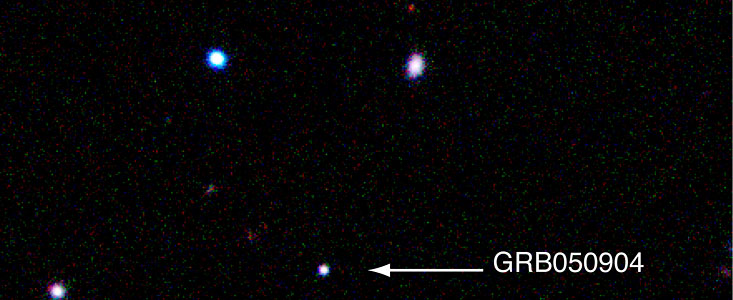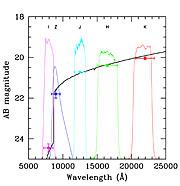Press Release
Star Death Beacon at the Edge of the Universe
Astronomers Find Farthest Known Gamma-Ray Burst with ESO VLT
12 September 2005
An Italian team of astronomers has observed the afterglow of a Gamma-Ray Burst that is the farthest known ever. With a measured redshift of 6.3, the light from this very remote astronomical source has taken 12,700 million years to reach us. It is thus seen when the Universe was less than 900 million years old, or less than 7 percent its present age.
"This also means that it is among the intrinsically brightest Gamma-Ray Burst ever observed", said Guido Chincarini from INAF-Osservatorio Astronomico di Brera and University of Milano-Bicocca (Italy) and leader of a team that studied the object with ESO's Very Large Telescope. "Its luminosity is such that within a few minutes it must have released 300 times more energy than the Sun will release during its entire life of 10,000 million years."
Gamma-ray bursts (GRBs) are short flashes of energetic gamma-rays lasting from less than a second to several minutes. They release a tremendous quantity of energy in this short time making them the most powerful events since the Big Bang. It is now widely accepted that the majority of the gamma-ray bursts signal the explosion of very massive, highly evolved stars that collapse into black holes.
This discovery not only sets a new astronomical record, it is also fundamental to the understanding of the very young Universe. Being such powerful emitters, these Gamma Ray Bursts serve as useful beacons, enabling the study of the physical conditions that prevailed in the early Universe. Indeed, since GRBs are so luminous, they have the potential to outshine the most distant known galaxies and may thus probe the Universe at higher redshifts than currently known. And because Gamma-ray Burst are thought to be associated with the catastrophic death of very massive stars that collapse into black holes, the existence of such objects so early in the life of the Universe provide astronomers with important information to better understand its evolution.
The Gamma-Ray Burst GRB050904 was first detected on September 4, 2005, by the NASA/ASI/PPARC Swift satellite, which is dedicated to the discovery of these powerful explosions.
Immediately after this detection, astronomers in observatories worldwide tried to identify the source by searching for the afterglow in the visible and/or near-infrared, and study it.
First observations by American astronomers with the Palomar Robotic 60-inch Telescope failed to find the source. This sets a very stringent limit: in the visible, the afterglow should thus be at least a million times fainter than the faintest object that can be seen with the unaided eye (magnitude 21). But observations by another team of American astronomers detected the source in the near-infrared J-band with a magnitude 17.5, i.e. at least 25 times brighter than in the visible.
This was indicative of the fact that the object must either be very far away or hidden beyond a large quantity of obscuring dust. Further observations indicated that the latter explanation did not hold and that the Gamma-Ray Burst must lie at a distance larger than 12,500 million light-years. It would thus be the farthest Gamma-Ray Burst ever detected.
Italian astronomers forming the MISTICI collaboration [1] then used Antu, one of four 8.2-m telescopes that comprise ESO's Very Large Telescope (VLT) to observe the object in the near-infrared with ISAAC and in the visible with FORS2. Observations were done between 24.7 and 26 hours after the burst.
Indeed, the afterglow was detected in all five bands in which they observed (the visible I- and z-bands, and the near-infrared J, H, and K-bands). By comparing the brightness of the source in the various bands, the astronomers could deduce its redshift and, hence, its distance. "The value we derived has since then been confirmed by spectroscopic observations made by another team using the Subaru telescope", said Angelo Antonelli (Roma Observatory), another member of the team.
Notes
[1] The MISTICI collaboration consists of astronomers from Osservatorio Astronomico di Roma (INAF), Osservatorio Astronomico di Brera (INAF), Osservatorio Astronomico di Arcetri (INAF), Universita` degli Studi di Milano - Bicocca, International School for Advanced Studies (SISSA) and Observatori Astronomic of Universitat de Valencia (Spain). In particular, Angelo Antonelli, Daniele Malesani, Vincenzo Testa, Paolo D'Avanzo, Stefano Covino, Alberto Fernandez-Soto, Gianpiero Tagliaferri, Guido Chincarini, Sergio Campana, Massimo Della Valle, Felix Mirabel, and Luigi Stella were notably active with the data analysis and observations. Prof. Guido Chincarini is the Italian Principal Investigator of the Italian research on GRBs related to the Swift satellite, which is funded by the Italian Space Agency (ASI).
More information
Preliminary communication about these results have been done via the "Gamma Ray Bursts Coordinates Network".
Contacts
Guido Chincarini
Osservatorio Astronomico di Brera (INAF)
Brera, Italy
Tel: +39 39 999 1157
Cell: +39 340 280 3612
Email: guido@merate.mi.astro.it
About the Release
| Release No.: | eso0528 |
| Legacy ID: | PR 22/05 |
| Name: | GRB050904 |
| Type: | Early Universe : Cosmology : Phenomenon : Gamma Ray Burst |
| Facility: | Very Large Telescope |
| Instruments: | ISAAC |
Our use of Cookies
We use cookies that are essential for accessing our websites and using our services. We also use cookies to analyse, measure and improve our websites’ performance, to enable content sharing via social media and to display media content hosted on third-party platforms.
ESO Cookies Policy
The European Organisation for Astronomical Research in the Southern Hemisphere (ESO) is the pre-eminent intergovernmental science and technology organisation in astronomy. It carries out an ambitious programme focused on the design, construction and operation of powerful ground-based observing facilities for astronomy.
This Cookies Policy is intended to provide clarity by outlining the cookies used on the ESO public websites, their functions, the options you have for controlling them, and the ways you can contact us for additional details.
What are cookies?
Cookies are small pieces of data stored on your device by websites you visit. They serve various purposes, such as remembering login credentials and preferences and enhance your browsing experience.
Categories of cookies we use
Essential cookies (always active): These cookies are strictly necessary for the proper functioning of our website. Without these cookies, the website cannot operate correctly, and certain services, such as logging in or accessing secure areas, may not be available; because they are essential for the website’s operation, they cannot be disabled.
Functional Cookies: These cookies enhance your browsing experience by enabling additional features and personalization, such as remembering your preferences and settings. While not strictly necessary for the website to function, they improve usability and convenience; these cookies are only placed if you provide your consent.
Analytics cookies: These cookies collect information about how visitors interact with our website, such as which pages are visited most often and how users navigate the site. This data helps us improve website performance, optimize content, and enhance the user experience; these cookies are only placed if you provide your consent. We use the following analytics cookies.
Matomo Cookies:
This website uses Matomo (formerly Piwik), an open source software which enables the statistical analysis of website visits. Matomo uses cookies (text files) which are saved on your computer and which allow us to analyze how you use our website. The website user information generated by the cookies will only be saved on the servers of our IT Department. We use this information to analyze www.eso.org visits and to prepare reports on website activities. These data will not be disclosed to third parties.
On behalf of ESO, Matomo will use this information for the purpose of evaluating your use of the website, compiling reports on website activity and providing other services relating to website activity and internet usage.
Matomo cookies settings:
Additional Third-party cookies on ESO websites: some of our pages display content from external providers, e.g. YouTube.
Such third-party services are outside of ESO control and may, at any time, change their terms of service, use of cookies, etc.
YouTube: Some videos on the ESO website are embedded from ESO’s official YouTube channel. We have enabled YouTube’s privacy-enhanced mode, meaning that no cookies are set unless the user actively clicks on the video to play it. Additionally, in this mode, YouTube does not store any personally identifiable cookie data for embedded video playbacks. For more details, please refer to YouTube’s embedding videos information page.
Cookies can also be classified based on the following elements.
Regarding the domain, there are:
- First-party cookies, set by the website you are currently visiting. They are stored by the same domain that you are browsing and are used to enhance your experience on that site;
- Third-party cookies, set by a domain other than the one you are currently visiting.
As for their duration, cookies can be:
- Browser-session cookies, which are deleted when the user closes the browser;
- Stored cookies, which stay on the user's device for a predetermined period of time.
How to manage cookies
Cookie settings: You can modify your cookie choices for the ESO webpages at any time by clicking on the link Cookie settings at the bottom of any page.
In your browser: If you wish to delete cookies or instruct your browser to delete or block cookies by default, please visit the help pages of your browser:
Please be aware that if you delete or decline cookies, certain functionalities of our website may be not be available and your browsing experience may be affected.
You can set most browsers to prevent any cookies being placed on your device, but you may then have to manually adjust some preferences every time you visit a site/page. And some services and functionalities may not work properly at all (e.g. profile logging-in, shop check out).
Updates to the ESO Cookies Policy
The ESO Cookies Policy may be subject to future updates, which will be made available on this page.
Additional information
For any queries related to cookies, please contact: pdprATesoDOTorg.
As ESO public webpages are managed by our Department of Communication, your questions will be dealt with the support of the said Department.




